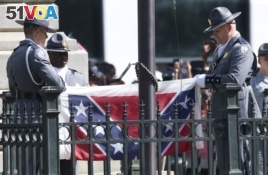05 May, 2017
U.S. President Donald Trump, in an interview with the Washington Examiner this week, wondered, "Why was there a Civil War? Why could that one not have been worked out?"
The United States fought the civil war from 1861-1865.
The war began after 11 southern states left the United States and formed the "Confederacy." Over 600,000 soldiers lost their lives before the Confederacy was defeated.
Now, over 150 years later, the battle is still fought in some communities over calls to remove flags, statues and other public displays connected to the Confederacy.
What was the Civil War about?
Civil War historian James McPherson wrote that "the Civil War was caused by differences between free and slave states over the power of the national government to stop slavery" in western territories.
It is the Confederacy's connection to slavery that recently led the southern city of New Orleans, Louisiana, to begin removing four monuments, or statues, connected to the Civil War and its aftermath.
Slavery was the buying and selling of Africans and other blacks who were forced to work in America, mostly in the South, without pay. Many were separated from their families and treated terribly by their owners.
Mitch Landrieu is the mayor of New Orleans. He believes that monuments connected to slavery should not be given an honored place in his majority African-American city.
He said, "The removal of these statues sends a clear and unequivocal message to the people of New Orleans and the nation: New Orleans celebrates our diversity, inclusion and tolerance."
Removal of Confederate monuments
The first monument, removed on April 24, recognized the Crescent City White League. League members fought against a racially integrated police department in the 19th century.
Jarvis DeBerry is a columnist for the Times-Picayune, a New Orleans newspaper.
He said the four monuments the city is removing went up after the U.S. government dropped control of the southern states. Control by the federal government lasted from 1865 to 1877. It was a time when African-Americans not only integrated the police departments, but also gained political power, DeBerry said.
"There were black people in positions of power. And yet when the Union armies withdrew and the South was allowed to govern itself again they created hell for black people. And again I think part of the hell they created was the erection of these monuments to remind anybody who might think otherwise that ‘no, you are not a real citizen and no, you don't have the rights that white people enjoy.'"
There has been some opposition to removing the Confederate monuments from New Orleans. Officials were so concerned about violence that workers covered their faces, so they could not be identified, while removing the first Confederate Monument.
Pierre McGraw is president of the Monument Task Committee. He said on Facebook that New Orleans should have added information about the Confederacy to the monuments, instead of removing them.
"People across Louisiana should be concerned over what will disappear next," he said.
Landrieu, the New Orleans mayor, rejects the idea his city is covering up its history.
Confederate monuments belong in a museum, where more information can be provided about the Confederacy's evil history, he said.
Confederate displays are not just an issue in New Orleans.
Racial shooting leads to removal of flag
In 2015, then South Carolina Governor Nikki Haley ordered the removal of the Confederate Flag from the state Capitol. She acted after a white man shot and killed nine people at an African-American church. The shooter said he wanted to start a race war.
Thomas Berger is a professor at Boston University who has written about how nations deal with horrible actions in the past.
For a long time, he said Confederate soldiers were seen as misguided people wanting to protect local control and traditions, rather than as defenders of a violent, racist system.

An honor guard from the South Carolina Highway patrol removes the Confederate battle flag from the Capitol grounds in Columbia, S.C., Friday, July 10, 2015, ending its 54-year presence there. (AP Photo/John Bazemore)
But that is changing. University of Tennessee Knoxville Professor Derek Alderman said Middle Tennessee State University is moving to change the name of a school building. It is now named for Nathan Bedford Forrest, a Confederate Army general and a leader of the Ku Klux Klan. The Klan carried out violent attacks against African-Americans.
The move away from naming buildings for people connected to the Confederacy or slavery is not limited to the South.
Yale University is located in the Northeastern state of Connecticut. The university is renaming Calhoun College, one of the school's 12 undergraduate residential colleges.
Yale President Peter Salovey announced the decision in February. He said John C. Calhoun, for whom the college is named, had said that slavery was good for society.
His opinion goes against Yale's most important values, Salovey said.
I'm Dorothy Gundy.
And I'm Bruce Alpert.
Bruce Alpert reported on this story for VOA Learning English. Hai Do was the editor.
We want to hear from you. Write to us in the Comments Section and share your views on 51VOA.COM.
_____________________________________________________________
Words in This Story
display - n. an arrangement of objects intended to inform people about something
monument - n. a building, statue, etc., that honors a person or event
unequivocal - adj. very strong and clear
diversity - n. the quality or state of including different races and ethnic groups
tolerance - n. willingness to accept feelings, habits, or beliefs that are different from your own
integrated - adj. including different races
hell - n. lots of problems and difficulties
erection - v. installing a structure such as monument or statue
museum - n. a building in which interesting and valuable things, such as paintings and sculptures or scientific or historical objects, are collected and shown to the public